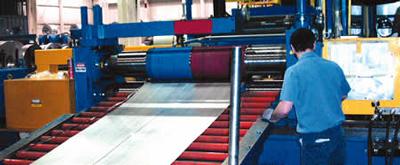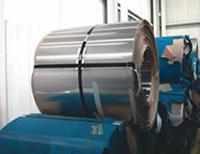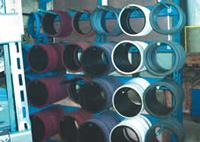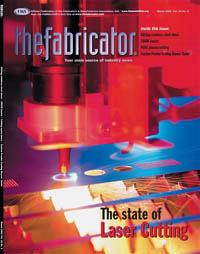- FMA
- The Fabricator
- FABTECH
- Canadian Metalworking
Categories
- Additive Manufacturing
- Aluminum Welding
- Arc Welding
- Assembly and Joining
- Automation and Robotics
- Bending and Forming
- Consumables
- Cutting and Weld Prep
- Electric Vehicles
- En Español
- Finishing
- Hydroforming
- Laser Cutting
- Laser Welding
- Machining
- Manufacturing Software
- Materials Handling
- Metals/Materials
- Oxyfuel Cutting
- Plasma Cutting
- Power Tools
- Punching and Other Holemaking
- Roll Forming
- Safety
- Sawing
- Shearing
- Shop Management
- Testing and Measuring
- Tube and Pipe Fabrication
- Tube and Pipe Production
- Waterjet Cutting
Industry Directory
Webcasts
Podcasts
FAB 40
Advertise
Subscribe
Account Login
Search
Special slitting for specialty metals
Stainless steel has its own issues
- By Fred Barrera and Ed Basta
- March 13, 2003
- Article
- Bending and Forming
As this transition to more challenging environments occurs, an on-time supply of high-quality processed stainless steels and other specialty metals becomes vital to U.S. industry. Many steel suppliers that process carbon steel grades are being asked to slit more exotic and often more difficult stainless steels. All too often both the processor and the customer are disappointed with the results.
Efficient and high-quality slitting of most stainless steels requires knowledge of the differences between carbon and stainless grades. It also demands a complete reassessment of equipment and tooling, as well as many peripheral processing and packaging issues. Although it is clear that carbon steels and stainless steels are different materials, it is not as obvious that some significant changes must be made when slitting stainless grades.
Slitting Equipment Issues
While both "pull" (nonlooping) and looping slitting machines can produce acceptable stainless strip, this article focuses on the important tooling, techniques, and peripheral processing issues that should be considered when slitting stainless steel on a modern looping slitter.
The first big difference between carbon and stainless coil slitting often is noted immediately after the coil is loaded on the slitter-the paper interleaf material in bright-annealed stainless must be taken up as the coil runs (see Figure 1).
The slitter must be equipped with an efficient paper take-up reel that doesn't allow the paper to drop off, an unsafe, cumbersome situation. In most cases, without the positive tension provided by the take-up reel, the paper won't drop off and risks getting pulled into the slitter itself.
Of course, polished-finish and bright-annealed stainless coils likely will require paper interleaving or a PVC adhesive plastic coating before slitting, so the slitter should have the ability to apply such surface protection to the material (see Figure 2).
The slitter's features, including overall cleanness, arbor size, power limitations, and physical contact areas with the material, all must be reconsidered when slitting stainless steels versus carbon grades. In general, the material properties, surface quality requirements, and higher overall cost of most stainless grades will result in slower slitting speeds, enhanced inspection, and a closer scrutiny of scrap levels. It is suggested that different tensioning rolls be used for stainless material if oiled carbon products are slit on the same equipment. The cleanness of the slitter cannot be overemphasized.
In most cases, the number of cuts per material thickness will be fewer for stainless than for carbon steel. If the slitter is overloaded by making too many cuts on a small-OD arbor, significant arbor deflection can result, causing myriad slitting defects. Additionally, the ability to control uncoiler back tension during the slitting operation is as important as ever. Material tension should not be allowed to vary widely or the strip will have a tendency to wander.
As for other equipment, total machine alignment is important in stainless steel slitting. Poor alignment, from coil payoff to slitting arbor and knives, to tension devices, to the final recoiler and coil separators, will cause problems such as camber, other coil shape defects, and possible surface damage. All equipment components that make contact with stainless material must be oil-free and made of material that cannot scratch the surface finish.
Slitter Tooling and Setup Considerations
After stainless slitting line capabilities, maintainance, and process controls have been assessed, the slitting tooling and setups must be evaluated. Some of the most critical differences between slitting carbon and stainless steels are the types of slitter knives and rubber stripper rings used. These are the areas in which those inexperienced in processing stainless steels often run into difficulties.
The slitting knives must be of the correct type and tool steel grade for the stainless material to be slit. Depending on the overall volume and the percentage of stainless versus carbon steel processed on a given slitter, the same D2 knife material may be used for both steels.
Knife rotation-gradually applying a knife that is wearing to thicker material until machine sharpening is required-can ensure good slitting quality and maximum knife life between sharpening cycles. A good edge on all slitting knives is required for camber- and burr-free material, whether it is stainless or carbon.
Additionally, the setup clearances for stainless steels are significantly different than those for carbon steel. In general, the clearances for stainless should be set larger than for carbon steels because of stainless steel's higher tensile strength. Proper break and shear ratios must be maintained for proper slit edges.
The rubber stripper ring sizes, hardness levels (durometer readings), and setup parameters are some other notable differences. Of particular importance is the stripper ring's OD relative to the slitting knives for the stainless material and thickness to be slit (see Figure 3). In general, female stripper ring ODs will be the same as those used for carbon slitting of the same thickness. The male rings, however, must be significantly larger than those used for carbon steel because of the additional force required to push the physically tougher stainless material off the knives.
The durometer value of the rings used for stainless steels typically must be much higher, usually in the 80 to 90 range versus 60 to 70 for carbon grades. An incorrect ring size, match, or durometer value often causes the slitting knives to push material off incorrectly, causing knife marks and other slitting problems.
Material Property Comparisons
Even when consistent, high-quality stainless steel coils are supplied, additional information about material properties is required to choose the proper number of cuts and set knife clearances accurately.
First, the general yield and tensile strength of the material should be known. Fortunately, this information usually is easy to obtain from stainless steel producers. Although most stainless coils are supplied with certified properties, the material supplier or a metallurgical expert sometimes might need to be consulted to determine these strength levels.
The knife clearance needed to make a good, clean break on the slit edge must be calculated from these values. Most modern slitters now use computer-assisted tooling programs that provide a recommended clearance value if the material parameters are known. However, the slitter operator or team should always be prepared to check programmed clearance numbers for adequacy, and they should not be afraid to change these if they are found to be unsatisfactory in production. The proof is always on the slit edge and shape.
The yield strength of stainless steel often matches that of harder mild carbon steels, but stainless steel's high chromium and nickel content produces much higher tensile strength and elongation, which usually require different knife clearances.
Additionally, the normal requirement for an oil-free surface on stainless steel can make an already tough job even more challenging, because frictional forces are increased at the knife edge. This additional friction results in shorter knife life when a large amount of stainless is processed. In some cases, a vanishing solution may be used to help decrease these frictional forces.
Stainless Slitting Techniques
Besides the unique material properties and surface quality of stainless steels, the actual material thickness and the required number of cuts also must be assessed. The correct arbor penetration relative to the material thickness will minimize arbor deflection. Another process setting that is somewhat unique to stainless slitting is the minor fanning out of the slit coils before recoiling. Along with control of overarm pressure on the recoiler as the slit stainless coils are rewound and an overall straight-line material flow on the machine, the control of these parameters is critical to a quality stainless steel slitting process.
Stainless Slitting Inspection
Once all the correct equipment, techniques, tools, and materials are in place and stainless slitting is proceeding well, the slitter operator still needs to know that the results will be satisfactory to the end user. Although process controls continue to advance, making detection inspection procedures less important over time, it remains a good practice to inspect slit width, slit edge quality, shape and camber, and, most important to most stainless steel users, surface quality.
Because surface damage can occur at several points in the slitting process, surfaces at those points should be inspected. Because the slitting speed for stainless steels usually is greatly reduced, a good visual inspection of the surface for more minor defects is possible. Once the coil is rewound, the end customer will perform the next evaluation of overall quality—and this is not the place the slitter would prefer the first surface inspection to be done.
The requirement for additional surface protection via interleaved paper or an adhesive PVC plastic coating on fine-finish and bright-annealed stainless coils makes the in-process inspection of surface quality even more important. Of course, the inspection also should note the satisfactory application of these surface protection options.
Postslitting and Storage Considerations
Finally, even after the slitting operation is completed and all in-process inspections have proved the slit coils totally conform to the requirements, the customer still might encounter a quality problem. An incorrect packaging, handling, or storage procedure can result in damage. This can occur at the slitting facility or at the customer's facility. Extra care must be taken to package and store expensive stainless steels correctly to prevent high waste and scrap costs.
Transitioning into the growing but more complicated world of stainless steel slitting takes a large amount of technical knowledge; practical experience; and commitment to the proper equipment, tooling, and training. Considering the higher cost of the material and the meticulous processing and inspections required to ensure a product meets or exceeds customer expectations, stainless steel users should make sure their slit coil suppliers have made this commitment.
About the Authors
Fred Barrera is the vice president of manufacturing for Atlas Steel Products Co., 7990 Bavaria Road, Twinsburg, OH 44087, 800-444-1682, fax 330-425-1611, Service@atlassteel.com, www.atlassteel.com. Atlas Steel Products Co. is a steel service center and welded tubing manufacturer that specializes in addressing heat and corrosion problems in many industries through the processing of stainless steels, aluminized, and other coated steels and tubing products in these alloys.
Ed Basta is the president and principal consultant for Quality Technology Services, 11199 Walnut Ridge Road, Chesterland, OH 44026, 440-796-2504, fax 440-729-1940, qualts@aol.com. Quality Technology Services is a metallurgical and quality science consulting firm that specializes in metalworking quality and metallurgy issues from materials selection to product failure analysis and testing.
Related Companies
subscribe now

The Fabricator is North America's leading magazine for the metal forming and fabricating industry. The magazine delivers the news, technical articles, and case histories that enable fabricators to do their jobs more efficiently. The Fabricator has served the industry since 1970.
start your free subscription- Stay connected from anywhere

Easily access valuable industry resources now with full access to the digital edition of The Fabricator.

Easily access valuable industry resources now with full access to the digital edition of The Welder.

Easily access valuable industry resources now with full access to the digital edition of The Tube and Pipe Journal.
- Podcasting
- Podcast:
- The Fabricator Podcast
- Published:
- 04/16/2024
- Running Time:
- 63:29
In this episode of The Fabricator Podcast, Caleb Chamberlain, co-founder and CEO of OSH Cut, discusses his company’s...
- Trending Articles
AI, machine learning, and the future of metal fabrication

Employee ownership: The best way to ensure engagement

Dynamic Metal blossoms with each passing year

Steel industry reacts to Nucor’s new weekly published HRC price

Metal fabrication management: A guide for new supervisors

- Industry Events
16th Annual Safety Conference
- April 30 - May 1, 2024
- Elgin,
Pipe and Tube Conference
- May 21 - 22, 2024
- Omaha, NE
World-Class Roll Forming Workshop
- June 5 - 6, 2024
- Louisville, KY
Advanced Laser Application Workshop
- June 25 - 27, 2024
- Novi, MI






























